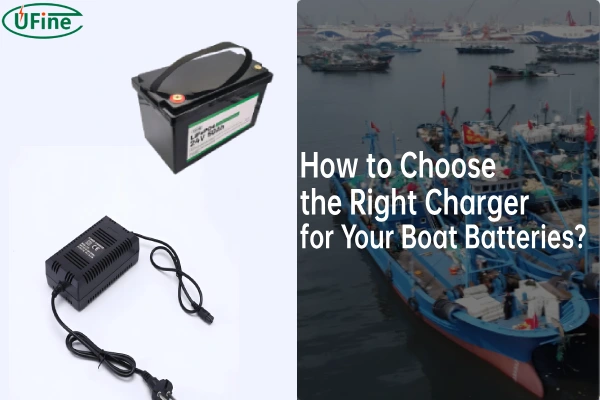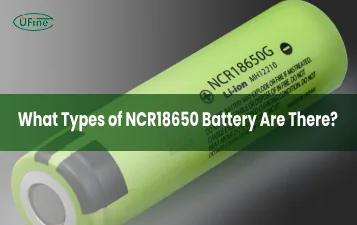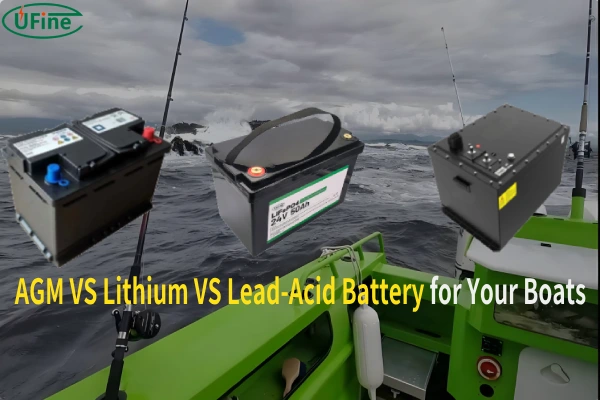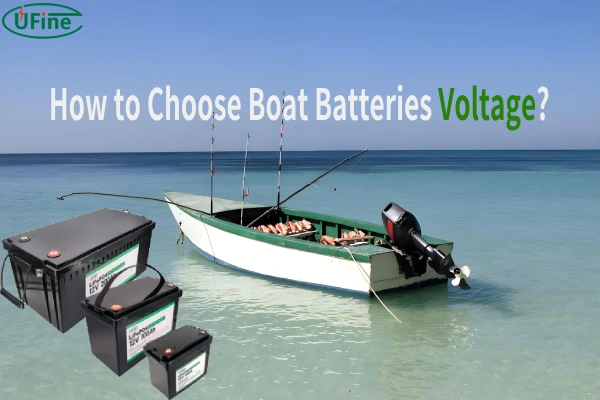The open water beckons with adventure, but before you set sail, you need to ensure your boat is equipped with the right power source. A reliable battery is the heart of your boat’s electrical system, powering everything from the engine to navigation lights, entertainment systems, and essential onboard amenities. But with a vast array of battery options available, choosing the right one for your boat can feel like navigating a choppy sea.
This comprehensive guide will equip you with the knowledge to make an informed decision, ensuring you select the perfect battery to fuel your boating adventures. We’ll delve into the key factors to consider, from battery types and voltage to capacity, size, and the crucial role of a compatible charger.
Part 1. Understanding your boat’s power needs
Before diving into the technical details of batteries, it’s essential to understand your boat’s specific power requirements. Different types of boats have vastly different needs, and choosing the wrong battery can lead to performance issues, safety concerns, and even damage to your boat’s electrical system.
-
Fishing Boats: These are often smaller vessels designed for leisurely fishing trips. They typically require a battery to power essential electronics like fish finders, GPS units, and trolling motors. The power demands are generally moderate, but you’ll want a battery that can handle the occasional heavy draw from a trolling motor.
-
Cruisers: Cruisers are larger boats designed for extended voyages and comfortable living. They require a more robust battery system to power the engine, navigation lights, onboard amenities like refrigerators, air conditioning, and entertainment systems. These boats often have multiple batteries connected in a bank for increased capacity and redundancy.
-
Sailboats: Sailboats rely heavily on batteries for propulsion, especially when the wind isn’t cooperating. Batteries power the engine, navigation equipment, and auxiliary systems like water pumps and bilge pumps. Sailboats often use deep-cycle batteries designed for sustained discharge, ensuring they can handle the demands of extended sailing trips.
Consider the specific features and systems your boat uses, the frequency of use, and the power demands of your equipment. This will help you determine the right type and capacity of battery for your boat.
Part 2. Boat batteries types
The world of boat batteries is diverse, with each type offering unique advantages and disadvantages.
AGM VS Lithium VS Lead-Acid Battery: Comprehensive Comparison
Here’s a closer look at the most common options:
1. Lead Acid Batteries: The Workhorse of the Sea
Lead acid batteries are the most traditional and widely used type in the boating world. Their affordability and readily available nature have made them a popular choice for decades.
-
Advantages:
-
Cost-Effective: Lead acid batteries are the most budget-friendly option, making them an attractive choice for boat owners on a tight budget.
-
Wide Availability: Lead acid batteries are readily available at most automotive and marine supply stores, ensuring easy replacement when needed.
-
Relatively Simple Maintenance: While they require some maintenance, lead acid batteries are relatively easy to care for, with simple procedures like topping off the electrolyte levels.
-
-
Disadvantages:
-
Shorter Lifespan: Compared to other battery types, lead acid batteries have a shorter lifespan, requiring more frequent replacements.
-
Susceptible to Spills and Leaks: The liquid electrolyte in lead acid batteries can leak or spill if the battery is mishandled or damaged, posing a safety hazard and requiring specialized cleanup procedures.
-
Lower Performance: Lead acid batteries have a lower power output and slower charging rate compared to other types, making them less suitable for high-demand applications.
-
2. AGM (Absorbent Glass Mat) Batteries: A Step Up in Performance
AGM batteries represent a significant advancement over traditional lead acid batteries. They utilize a special fiberglass mat to absorb the electrolyte, effectively immobilizing it. This innovative design offers several key benefits:
-
Advantages:
-
Enhanced Safety: The immobilized electrolyte eliminates the risk of spills and leaks, making AGM batteries significantly safer than lead acid batteries. This is crucial in confined spaces or where accidental spills could cause damage or pose a health hazard.
-
Superior Performance: AGM batteries boast a higher power output and can deliver more energy than lead acid batteries. This translates to a more robust performance in demanding applications requiring sustained power delivery, like high-performance boats or those with extensive onboard electronics.
-
Longer Lifespan: Due to the immobilized electrolyte, AGM batteries experience less internal corrosion and degradation. This results in a longer lifespan, requiring fewer replacements and reducing long-term costs.
-
Improved Durability: The robust construction and immobilized electrolyte make AGM batteries more resistant to vibration and shock. This makes them ideal for applications involving rough seas or frequent movement, like off-road boats or those used in challenging conditions.
-
Faster Charging: AGM batteries can charge faster than traditional lead acid batteries due to their improved internal conductivity. This is particularly advantageous in applications where quick charging is essential, such as in emergency situations or when frequently using the boat’s electrical systems.
-
-
Disadvantages:
-
Higher Cost: The advanced technology and construction of AGM batteries make them more expensive than traditional lead acid batteries. This cost difference can be a significant factor in budget-conscious applications.
-
Limited Capacity: While AGM batteries offer superior performance, they generally have a lower capacity than traditional lead acid batteries of the same size. This means they can store less energy, potentially limiting their suitability for applications requiring extended run times.
-
Temperature Sensitivity: AGM batteries are more sensitive to extreme temperatures than traditional lead acid batteries. They can experience reduced performance or even damage in very hot or cold environments.
-
3. Lithium-Ion Batteries: The Future of Marine Power
Lithium-ion batteries are the most advanced type of battery currently available for boats. They offer a significant leap forward in performance, lifespan, and efficiency.
-
Advantages:
-
Highest Power Output: Lithium-ion batteries deliver the highest power output among all battery types, making them ideal for demanding applications like high-performance boats, electric outboards, and those with extensive power needs.
-
Longest Lifespan: Lithium-ion batteries have the longest lifespan of any battery type, requiring fewer replacements and reducing long-term costs.
-
Lightest Weight: Lithium-ion batteries are significantly lighter than lead acid or AGM batteries of the same capacity, making them ideal for boats where weight is a critical factor.
-
Faster Charging: Lithium-ion batteries charge much faster than other battery types, making them convenient for frequent use and reducing downtime.
-
-
Disadvantages:
-
Highest Cost: Lithium-ion batteries are the most expensive option, representing a significant investment for boat owners.
-
Specialized Chargers: Lithium-ion batteries require specialized chargers designed for their specific chemistry, adding to the initial investment.
-
Temperature Sensitivity: Lithium-ion batteries are more sensitive to extreme temperatures than other types, requiring careful consideration of storage and operating conditions.
-
Part 3. Voltage: matching the power to your boat
Battery voltage is a critical factor in ensuring compatibility with your boat’s electrical system. Choosing the wrong voltage can damage your boat’s electrical components, leading to costly repairs.
-
12 Volt: Most small boats, including fishing boats, dinghies, and smaller cruisers, use 12-volt batteries. These batteries are generally sufficient for powering basic electronics and accessories.
-
24 Volt: Larger boats, like cruisers and sailboats with more extensive electrical systems, often use 24-volt systems. This requires two 12-volt batteries connected in series, doubling the voltage and providing more power.
-
36 Volt: Some larger boats, particularly those with electric propulsion systems, may use 36-volt systems. These systems require three 12-volt batteries connected in series.
Always consult your boat’s owner’s manual or a qualified marine electrician to determine the correct voltage for your boat’s electrical system.
Part 4. Capacity: how much power do you need?
Battery capacity, measured in amp-hours (Ah), determines how much energy a battery can store. A higher amp-hour rating means the battery can provide power for a longer duration.
-
Small Boats: A 50-100 Ah battery is typically sufficient for small boats with basic power needs, like powering a trolling motor, fish finder, and navigation lights.
-
Larger Boats: Larger boats with more demanding power requirements, like cruisers and sailboats with extensive onboard amenities, may need a battery bank with a combined capacity of 200 Ah or more.
Consider the amount of time you plan to use your boat’s electrical systems, the power demands of your equipment, and the frequency of use when choosing battery capacity.
Part 5. Size: finding the right fit for your boat
Battery size is an important consideration, especially for boats with limited space. You need to ensure the battery fits securely in the designated space on your boat, preventing movement and potential damage.
-
Small Boats: Compact batteries are ideal for small boats with limited space, maximizing storage while providing sufficient power.
-
Larger Boats: Larger boats may have more room for larger batteries, allowing for greater capacity and extended run times.
Measure the available space in your boat’s battery compartment before purchasing a battery, ensuring a snug fit and preventing any potential hazards.
Part 6. Choosing the right charger: completing the power puzzle

Choosing the right charger is just as important as choosing the right battery. The charger should be compatible with the type of battery you have and should provide the correct voltage and amperage for charging.
-
Types of Chargers:
-
Smart Chargers: These chargers automatically adjust the charging rate based on the battery’s condition, ensuring optimal charging and extending battery life.
-
Trickle Chargers: These chargers provide a slow trickle charge to maintain the battery’s charge level, preventing deep discharge and extending its lifespan.
-
Multi-Stage Chargers: These chargers use multiple stages to charge the battery efficiently, starting with a bulk charge to quickly bring the battery up to a certain level, followed by an absorption charge to fully charge the battery, and finally a float charge to maintain the battery’s charge level.
-
-
Choosing a Charger:
-
Battery Type: Choose a charger specifically designed for the type of battery you have, whether it’s lead acid, AGM, or lithium-ion.
-
Voltage: The charger’s voltage should match the battery’s voltage.
-
Amperage: The charger’s amperage should be appropriate for the battery’s capacity. A higher amperage charger will charge the battery faster, but it’s important to choose a charger that doesn’t exceed the battery’s recommended charging rate.
-
Marine-Rated: Ensure the charger is marine-rated and designed for outdoor use, as it will be exposed to the elements.
-
Related Tags:
More Articles

Understanding the Types of NCR18650 Batteries
Explore NCR18650 battery types in-depth. Compare models like B, GA, PF, and BD, and learn their chemistry, specs, uses, and safety features.
Curved Battery Pack vs. Flat Battery Pack: A Comprehensive Comparison for Flexible Electronics
Curved battery packs vs flat: compare flexibility, use cases, and performance to choose the right power source for modern electronic devices.
Where to Buy 3.7 V Lithium Ion Battery 850mAh Nearby?
Where to buy a 3.7 V lithium-ion battery 850mAh nearby? Learn specs, how to choose the right one, and where to buy it fast from nearby or direct from makers.
CR123A 3.0 V Lithium Battery vs 16340 Battery: Difference explained
CR123A and 16340 batteries look alike but differ in voltage, safety, and use. Learn the key differences to choose the right one for your device.
NCR18650B Battery Explained: Uses, Specs, Lifespan
Discover everything about the NCR18650B battery, including specs, types, lifespan, applications, and tips to spot fakes before you buy.





